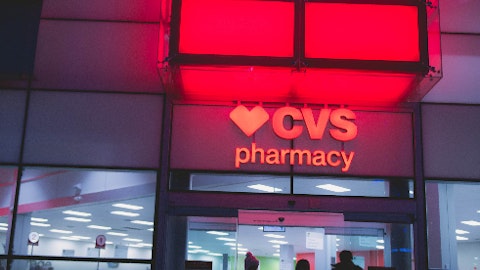Thibault Boutherin : Just one on albumin to start. The number seems to imply you had a very strong acceleration of our albumin sales in the third quarter. So I just want to understand what happened there. Is there any one-off? That’s the first question. And second one on deleveraging. And beyond the Shanghai RAAS stake sale that you kind have confirmed, do you see have an appetite to do another transaction before the end of 2024? And how large this deal would need to be in order for you to get to your leverage target? Like does it need to be as big as Shanghai RAAS or could you do something smaller and get there?
Victor Grifols Deu: On the first one, on the albumin question. No, we are seeing strong momentum in albumin, both in China and other important regions globally, and we are meeting our demand. As the plasma is coming back, we are meeting this demand that is out there for us. So it’s perfectly in line and it’s fully, let’s say, controlled.
Thomas Glanzmann : Thibault, Thomas here. We are actually very focused now 100% on signing the China transaction and are actually, at this point in time, not looking at anything else. We believe that the organic deleveraging combined with the transaction is going to get us to the target that we set for ourselves for ’24.
Nuria Pascual : Then next question is coming from Alvaro Lenze from Alantra Equities.
Alvaro Lenze : The first one is, if you could provide some additional detail on the evolution of alpha-1, sales seem to be a bit weak. I don’t know whether it’s that’s final demand or increased competition from other plasma players? And the second is if you could provide some guidance on cash flow. I see that investment in working capital remains very high. I don’t know if we should expect continued investment in Q4 and also into 2024.
Victor Grifols Deu: I take the first one. Alvaro, on alpha-1, yes, as we said, we are seeing today kind of flattish evolution in this franchise for us. There are many, many components. As you know, we have a pretty unique, let’s say, business model when it comes to commercial, especially in the U.S. and our historical markets. After the pandemic, we are fine-tuning this model. As you know, a key important factor for the model is the first piece in the funnel, is the testing piece. Just in May, we launched the new testing tool, which is the AlphaID at Home which is the complement to the health care professional testing model. So we are fine-tuning there. We expect this, let’s say, flattish trend seeing recently will be turning around during 2024 as I said, we made some small tweaks in our operating model to adapt to the new times after the pandemic.
Alfredo Arroyo : Alvaro, to your question of the cash flow, in the Q1, we have that hit as you all know, the restructuring cost. Most of the payments were done in the Q1. And since then, we’ve seen a significant positive increase on cash flow. And we’re going to see this in not only in Q1 — Q2 and Q3, but also in Q4. Regarding the inventories, yes, we’ve seen some increase in this quarter. But year-to-date, we are in the same days, inventory days around 300, which is in line with the previous year. Remember that just by maintaining the number of days, but due to the increase of the activity, the sales activity with this double-digit growth did require additional inventory. But for the year end, we’re going to see a very positive cash flow before that service.
Nuria Pascual : We have a question from Guilherme Sampaio from CaixaBank.
Guilherme Sampaio : So first one, a follow-up on this previous question. In terms — specifically in organic deleveraging. So we keep seeing net debt going up. When should we see a decline in net debt already next quarter or something for the next year, actually the cost effect of the deleveraging transaction that you are anticipating? And second, if you could touch upon the slowdown in the diagnostic area that we’ve seen specifically in this quarter?
Alfredo Arroyo : Okay. For the first question, the net debt reduction will be seen primarily on the back of the cash proceeds coming from the divestment because even though we see that our operational cash flow is going to keep improving during this year and next year, but we need to deleverage to reduce basically the interest expense.
Victor Grifols Deu: On the diagnostic question, you talk about the slowdown in this quarter. If I understood correctly, it’s good to remind that in Q2, we had an exceptional, let’s say, revenue or income coming in this one that, of course, is an exceptional one, and it’s not happening in the next — in this quarter or the others to come.
Nuria Pascual : Okay. Good. And now we have a couple of follow-ups. So Tom, I think you have some additional questions.
Thomas Jones : I just wondered, it was a broader follow-up question around your kind of building pipeline. And if I look across everything, you’ve got a building number of assets, whether it’s the 2 GIGA products, 564 and 2339, you’ve got the Alkahest, the AMD product, the 4290 product, then the 6019 and 6021 I think from Alkahest as well, plus you’ve got the Alzheimer’s vaccine. You got all these sort of non-plasma, like some of the Alkahest ones and plasma products, but you’ve got a lot of kind of noncore products building up in the pipeline, which is great. But I just wondered kind of what your long-term thinking around the development of these products is because to be frank, at the moment, the market just puts the multiple on the R&D spend.




